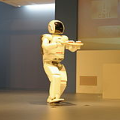Humanoid robots could replace humans in hazardous situations but most of such situations are equally dangerous for them, which means that they have a high chance of being damaged and falling. We hypothesize that humanoid robots would be mostly used in buildings, which makes them likely to be close to a wall. To avoid a fall, they can therefore lean on the closest wall, as a human would do, provided that they find in a few milliseconds where to put the hand(s). This article introduces a method, called D-Reflex, that learns a neural network that chooses this contact position given the wall orientation, the wall distance, and the posture of the robot. This contact position is then used by a whole-body controller to reach a stable posture. We show that D-Reflex allows a simulated TALOS robot (1.75m, 100kg, 30 degrees of freedom) to avoid more than 75% of the avoidable falls and can work on the real robot.
翻译:人类机器人可以在危险的情况下取代人类,但大多数此类情况对他们同样危险,这意味着它们极有可能受损和坠落。 我们假设人类机器人大多用于建筑物,这使他们有可能靠近墙壁。 为了避免摔倒,它们可以像人类那样靠在最靠近的墙上, 只要它们能在几毫秒内找到手放放的地方。 文章引入了一种叫D- Reflex的方法, 即学习神经网络, 以根据墙的方向、 墙距离和机器人的姿势选择这种接触位置。 这个接触位置随后被一个全机控制器用来达到稳定姿势。 我们显示, D- Reflex允许模拟TALOS机器人( 1. 75米、 100公斤、 30 度的自由度) 来避免超过75%的可避免的坠落, 并且可以操作真正的机器人 。




